Please Note- this website is best viewed on a desktop/laptop as it is not mobile-friendly. I am working on trying to convert it!
Joseph Austin Benwell was an artist and engraver who recorded scenes on everyday life in the far-flung empire, informing readers of publications such as the Illustrated London News in the days before the use of photography was widespread. It is known that he was resident in India in the mid 1850s until early 1857, when he departed on the ship 'Bengal' from Madras bound back to London via Marseilles. It appeared he left before the Indian Mutiny began in May 1857. Benwell was also in India, Burma and China earlier in his life, probably in the 1840s or early 1850s. He cannot be found in the 1841 census (to date), indicating he could possibly have been on his travels at that time.
Benwell's black and white engravings and illustrations in books and journals from the 1850s and 1860s are very evocative of the 'British in India' era, and are of historical and social interest. Some of his illustrations feature Calcutta, where he was a resident in the 1850s.
For example, the full-page illustration 'Methods of conveying cotton in India to the Ports of Shipment' in the Illustrated London News of 20 April 1861 (shown below) is accompanied by an article discussing concerns over the supply of cotton to Britain at the start of the American Civil War (1861-1865). The Southern States had the monopoly on sourcing cotton to Britain, and concern over the war meant an impending crisis in the cotton-manufacturing industry in England. Urgent discussions were held on the merits or otherwise of sourcing more cotton from India. The illustration highlights the immense difficulties faced in ensuring cotton supplies reached the ports of India. Once at the ports, the onward journey of cotton by ship to Britain was relatively safe. The problem arose in the methods of transporting cotton huge distances, maybe a thousand miles or so, overland from the production areas to the ports. River transport was dependent on the seasons, rivers often being either flooded or dry, and steamships often not available or booked months ahead. The illustration depicts some of the obstacles faced in transporting cotton, including the state of the roads and tracks travelled by loaded bullock carts, the danger from capsizing top-heavy small boats on rivers and even the risk of cotton bales catching fire from cooking fires lit onboard by the boatmen.
He did illustrations for the book ‘The Three Presidencies of India: a History of the Rise and Progress of the British Indian Possessions, from the Earliest Records to the Present Time’ by John Capper, 1853. Publisher: Ingram, Cooke and Co., London. He also illustrated ‘Our Indian Army: A Military History of the British Empire in the East’ by Captain Rafter, 1855, Publisher: David Bryce, 48 Paternoster Row, London. The dates of these publications indicate the artwork was researched and started possibly from the late 1840s onwards, or very early 1850s. Benwell’s entry in the ‘Dictionary of Indian Biography' (C E Buckland, 1906) refers to these books: ‘… illustrated Capt. M. Rafter's Our Indian Army, and Capper's Three Presidencies of India: nearly all his drawings on wood are in the periodicals and journals of the 'sixties, such as the Illustrated London News, and, to about 1876, the publications of the Religious Tract Society.'
Benwell produced illustrations on life in India for ‘The Illustrated London News’ (ILN) between 1857 and 1864, and illustrated articles about the Indian Mutiny (1857-58). Some of his engravings also appeared in the French ‘L’Univers Illustre’ at about the same time. A thesis ‘India in the Illustrated London News 1857-1906’ (D J Jessop 1986, Australian National University, Canberra) refers to Benwell as one of the travelling artists whose works appeared in the Illustrated London News during the 1850s and 1860s. It makes some interesting observations about the importance of engravings in the Illustrated London News as a popular source of information about India for the general public in Victorian Britain.
He illustrated the series ‘The Indian Nabob of 100 years ago’, by G. E. Sargent in ‘The Leisure Hour, a Family Journal of Instruction and Recreation’ 1858, about life in India in the mid 18th century at the time of Clive of India.This included front cover pages for chapters nine to 58, and various other scenes of Indian life in the 1858 edition of The Leisure Hour, for example the Massacre of Delhi (1857). In ‘The Sunday at Home’ (1862, p 504-522) he illustrated a series about British experiences during the Indian Mutiny - ‘Indian Experiences in 1857-58’, by Miss Vaughan, daughter of the Rev Dr Vaughan of the Religious Tract Society. At the outbreak of the Indian Mutiny she was residing with her sister, whose husband, the Principal of the Government College at Bareilly, perished during the mutiny.
Many of Benwell’s scenes depicting Indian life appeared in the publications of the Religious Tract Society (RTS) in journals such as The Leisure Hour and The Sunday at Home (above). They also feature in RTS books such as ‘Rays from The East, or Illustrations of the Holy Scriptures, derived principally from the Manners, Customs, Rites, and Antiquities of Eastern Nations’ (1871) and ‘True Tales about India, its Native Princes and British Rulers’ 1876 by S J Ballard. Refer to the section on Victorian Religious Publications for more scenes of India.
The entry for Joseph Austin Benwell in the 'Dictionary of Indian Biography' (C E Buckland, 1906) states he was '..conspicuous for original and pleasing delineations of native life, landscape and buildings in India, evidently drawn on the spot...'
His entry in the Modern English Biography (Vol IV c.373, Frederic Boase, publ. Frank Cass & Co Ltd 1892, 1908, 1965) states that he was 'one of the very few artists who have produced accurate drawings' of people from the east.
Shown below are some examples of scenes from India by Joseph Austin Benwell. For more pictures of India, please also refer to the page 'Victorian Religious Publications'.
Victorian Religious Publications

'Elephant Battery on the march' Illustrated London News 1858 (Indian Mutiny)
'The ordnance and stores in Indian armies are usually drawn by bullocks, but the guns of large calibre have a pair of elephants harnessed to each, tandemwise, as shown in the Illustration, which represents a gun of the elephant battery on the march. ...... An attempt was accordingly made some twenty years ago to harness and break in the elephant for drawing large guns, the experiment was attended with great success, and since then elephant batteries were formed, and have been extensively employed in our many important military expeditions. In the graphic description given by the Times correspondent of the march to Lucknow, and the capture of that city, the elephant gins are especially referred to as contributing to the success of that important undertaking.'
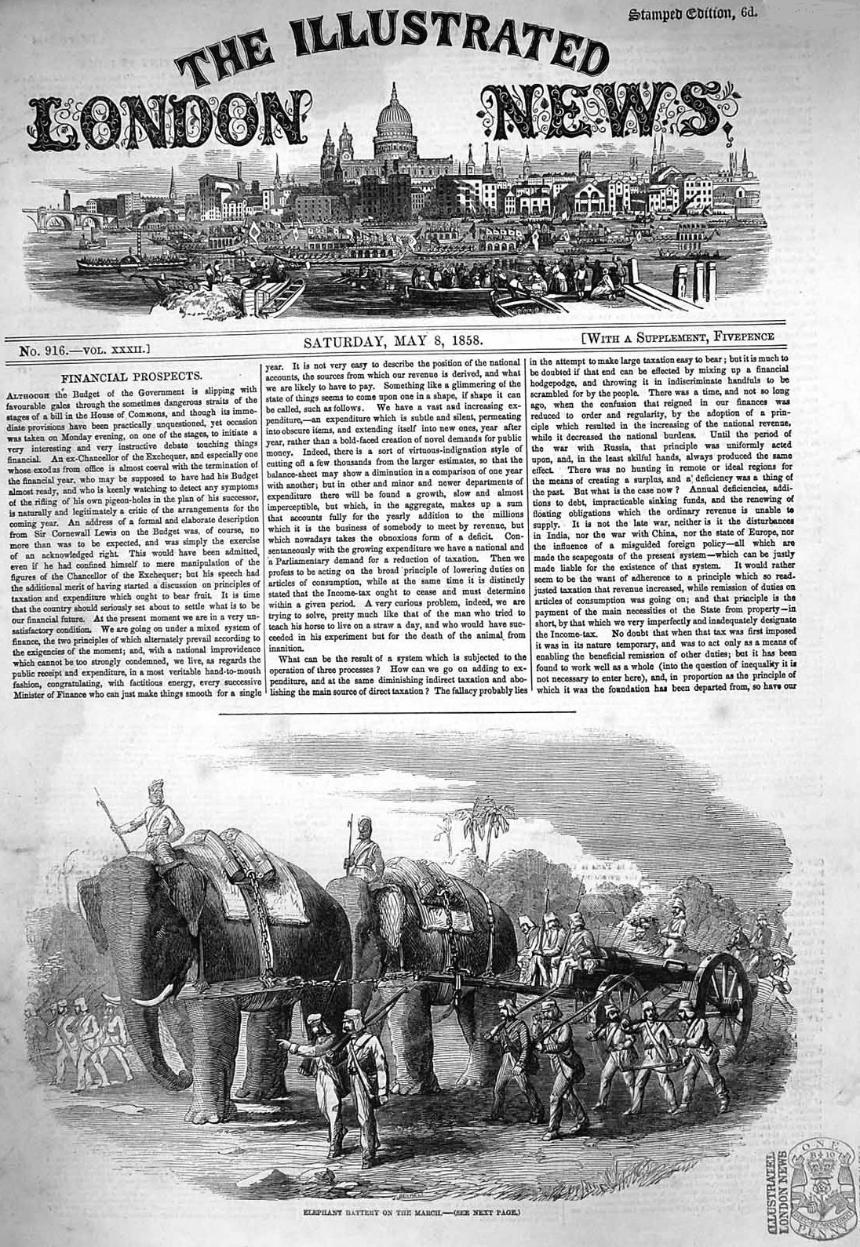
'Elephant Battery on the march' Illustrated London News 8 May 1858 (Indian Mutiny) -full front cover page
'Indigo cultivation in Lower Bengal' The Leisure Hour, 1861
‘The difficulties of the indigo planter in Bengal have recently brought them prominently into notice. Late intelligence from India informs us, that many indigo factories have been closed. How this state of things has been brought about, it is not quite so easy to say, The planters and their friends maintain that the Bengal Government is to blame for it, inasmuch as it has ever viewed them with a jealous eye, and has rather thwarted than furthered their schemes….. Indigo is a native of India, and is there called neel or leel. There can be no doubt that the dye was known to the Greeks and Romans, from the description given of Indicon by Dioscorides and Indicum by Pliny…. The Indigo of commerce is obtained from a plant called Indigofera Tinctoria, which forms only one of numerous different species, all of which yield a blue dye, although to a smaller extent and of an inferior quality…. The cultivation of indigo is carried on in different parts of India, as in Agra, Lahore, Surat, Oude etc.,and in the Madras Presidency; but the finest is produced at the factories of Jessore and Kishnagur in Bengal….. The Zemindars have often been accustomed, on such occasions, to assemble large bodies of natives armed with ‘lattials,’ or sticks, just as the indigo was ready for cutting, and to drive off the planters’ people, and then carry off the crop. … While we write, towards the end of 1861, it is reported from India that the season has been a gloomy one. The contests between the planters and ryots are continued. Heavy rains in Bengal and droughts in Madras have been disastrous to the crops. The stock held in Europe is lower than at any date for the last forty years. Let us hope, however, that by the wise measures of the Indian Government, peace may be restored to the troubled districts, and that a long period of prosperity may yet fall to the indigo planters and cultivators.’
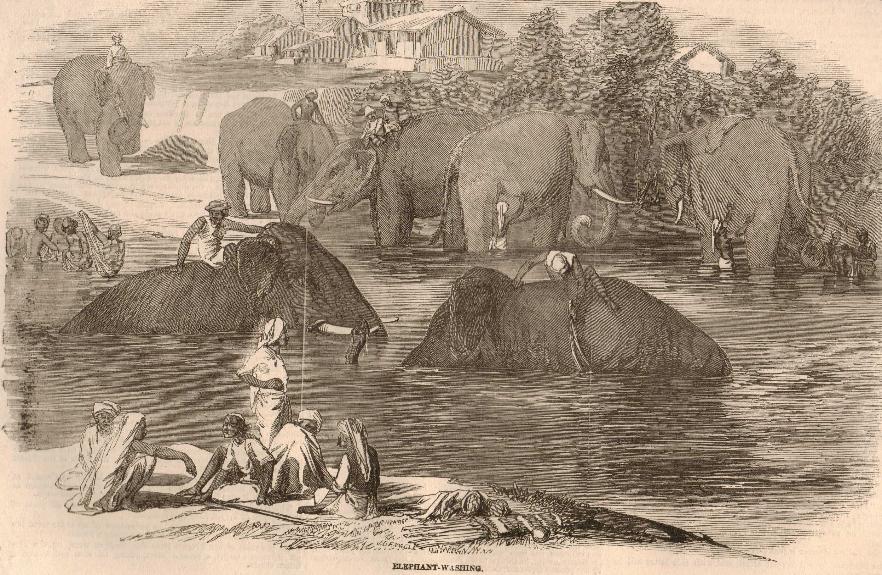
'Elephant Washing' Illustrated London News 1858
'The accompanying Sketch was taken at the village of Chorparun, a halting-place in the Benares Road. A large natural tank of water, formed by the rains, was contiguous to the village, The elephant is quite at home in the water. Sinking his huge body below the surface until nothing is seen of him but a few inches of his proboscis, elevated to supply him with air, he flounders to and fro and revels in the cool element. Sometimes, filling his trunk with water, he will spout it with great violence in the direction of a fellow monster-bather. This sally is returned with interest, and it is not uncommon to see this sport prosecuted so vigorously that the beholder is left in some doubt as to whether it really is all play, or whether the joke has not been carried so far that one or the other is betrayed into rather more temper than a mere frolic would seem to justify.
There is, however, usually the best understanding between these animals and their keepers or drivers, who can at any point put a stop to the fun when it interferes with the more serious business of washing. This operation is performed with the hand on parts easily reached, and on more distant portions by means of a broom of strong rushes bound tightly together. The washing being over, the the elephant places his trunk so as to form an incline, up which the driver adroitly ascends. On leaving, the animal usually draws up a trunk full of water, with which he amuses himself, occasionally giving the driver a shower-bath as they proceed to the camping ground.'
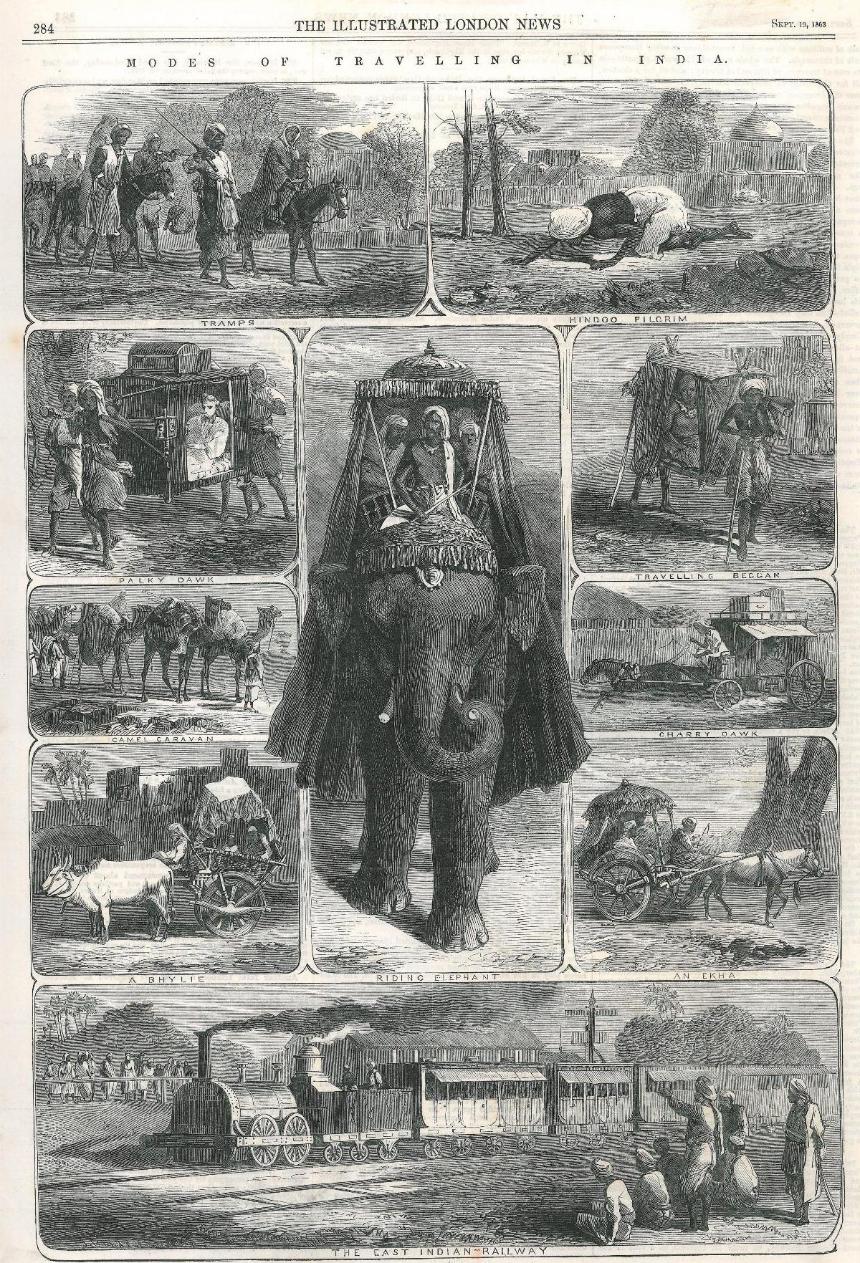
'Modes of Travelling in India' Illustrated London News 1863
(full page- Tramps, Hindoo Pilgrim, Palky Dawk, Travelling Beggar, Riding Elephant (centre), Camel Caravan, Charry Dawk, a Bhylie, an Ekha, The East Indian Railway)
This illustration also appeared in the French journal ‘L’Univers Illustre’, on 18 May 1864 (no. 329), illustrating an article called ‘Comment on voyage dans L’Inde' by Paul Parfait. Paul Parfait was a journalist, novelist and secretary to Alexandre Dumas.
'Escape of some of the Europeans from Bareilly' (1857-58, Indian Mutiny), The Sunday at Home, a Family Magazine for Sabbath Reading 1862
'Meeting the Nawab of Rampore in the night journey towards the hills' (1857-58, Indian Mutiny), The Sunday at Home, a Family Magazine for Sabbath Reading 1862
'Palki Travelling' The Sunday at Home, a Family Magazine for Sabbath Reading 1862
'Indian Poojah to Tools' The Sunday at Home, a Family Magazine for Sabbath Reading 1862
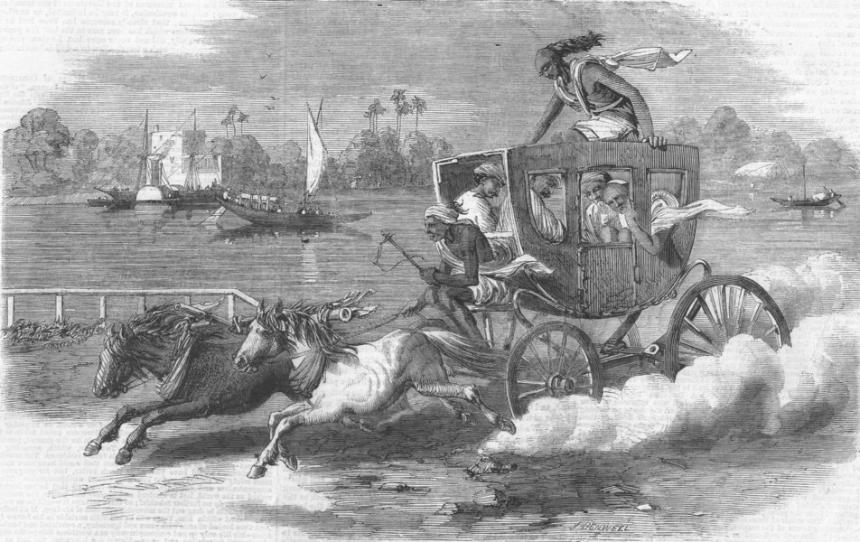
'The Keranchie, or Kidrapore Omnibus' Illustrated London News 1859
This illustration also appeared in 'L'Univers Illustre' (published in Paris) 26 January 1860.
'L'Inde, plus heureuse, entre dans une voie de pacification. Plusieurs rebelles se sont rendus; un de nos correspondants temoin de l'arrivée de quelques-uns á Kidrapore en Keranchi, sorte d'omnibus Indien, nous a envoyé le dessin si pittoresque de la page 68.'
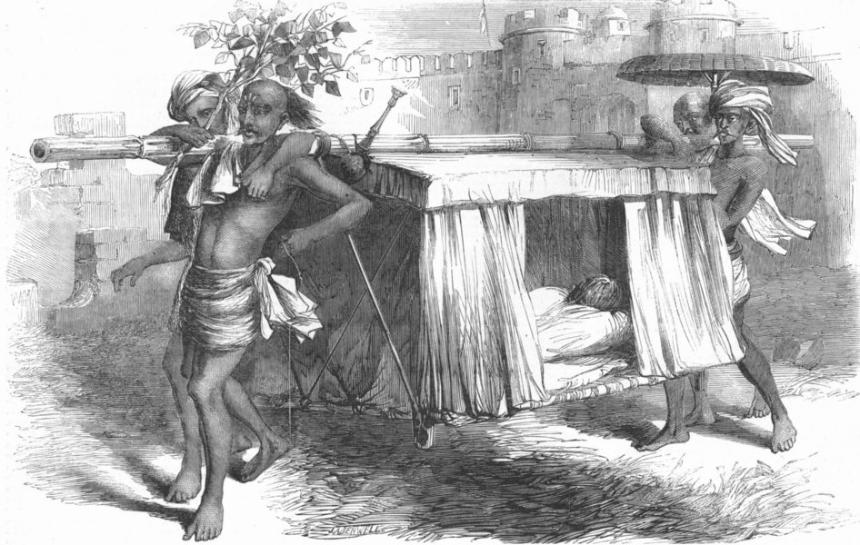
'Hindostanee dhoolie, used by hospitals and in the field' Illustrated London News 1857
'The Dhoolie is a simply-constructed palkie, or palankeen, which is carried by four bearers, who belong to a distinct caste, living chiefly in the lower provinces of the Bengal Presidency. These vehicles are used much on the march for conveying the sick; more especially those who are in too delicate a state to bear the jolting gait of the camels and elephants on which they are usually placed, perched on top of the tents and other camp equipage. Every European hospital establishment in Bengal has its complement of dhoolies attached, with a staff of bearers, under a sirda, paid by the Government. The dhoolies are used for carrying those of the sick who are too feeble to gain the hospital on foot. In action these vehicles are of the greatest service for carrying to the rear those who fall wounded, and who are lucky enough to have an opportunity of availing themselves of them: they are exceedingly comfortable to ride in, owing to their light and elastic construction. The bottom is simply four bamboos, fastened to four short legs, forming a frame, which is tightly corded over with country rope, to form a sacking. The frame is supported by an iron suspender at the head, and another at the foot; the long bamboo poles passing through rings formed by the bend of the suspenders; and a slight framework of bamboo at the top, covered with stout wax cloth, with curtains of white canvas, complete the dhoolie. These elastic materials give kindly to the step of the bearers: the curtains keep off the sun, and at the same time admit any breeze that may be stirring. On the sacking is placed a razzi, or thick quilted coverlet, which is the only bed (sick or well) used by our soldiers serving in India.
It will be remembered that early in the Indian mutiny a doctor of one of the revolted regiments at Meerut, when on his way to visit his hospital the day following the outbreak, saw a dhoolie approaching, bearing the body of Colonel Finnis. He says "On my way down (to the hospital) a dhoolie approached, and was passing me, when I stopped the bearers, and asked what they carried. They answered 'The Colonel Sahib.' It was poor Colonel Finnis' body, which had just been found where he fell, and was being carried towards the churchyard."'
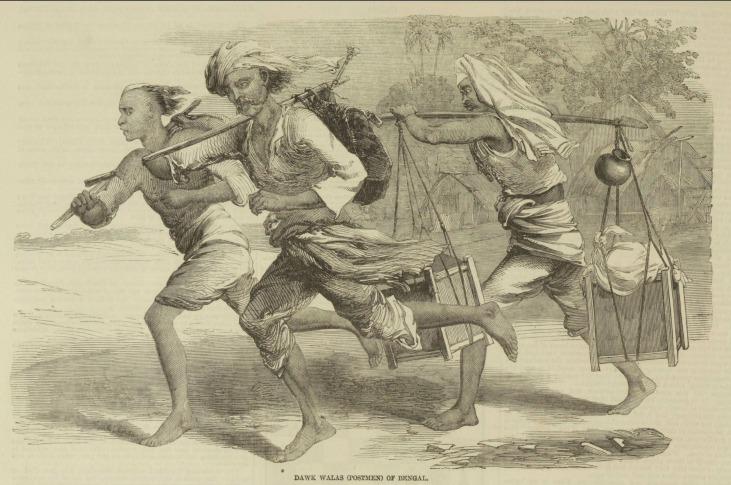
' Dawk Walas (Postmen) of Bengal' Illustrated London News 1858
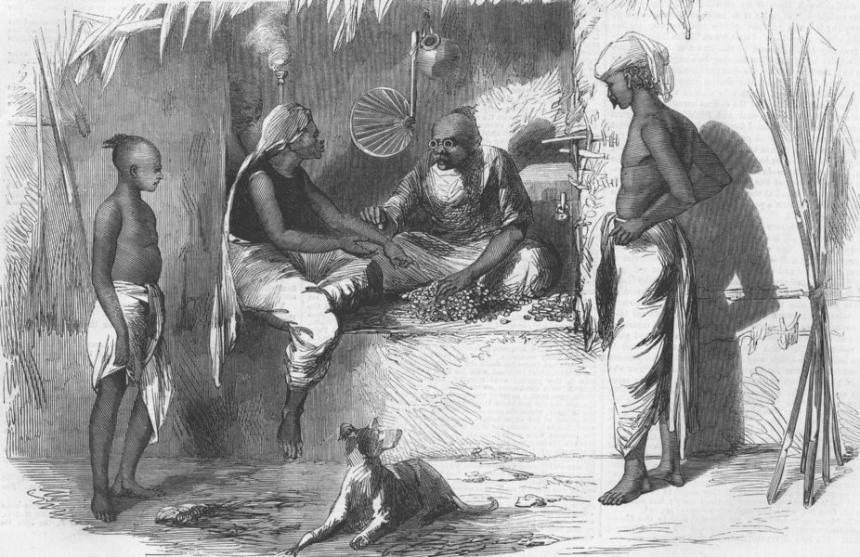
'Hindoo Money-Changer' Illustrated London News 1859
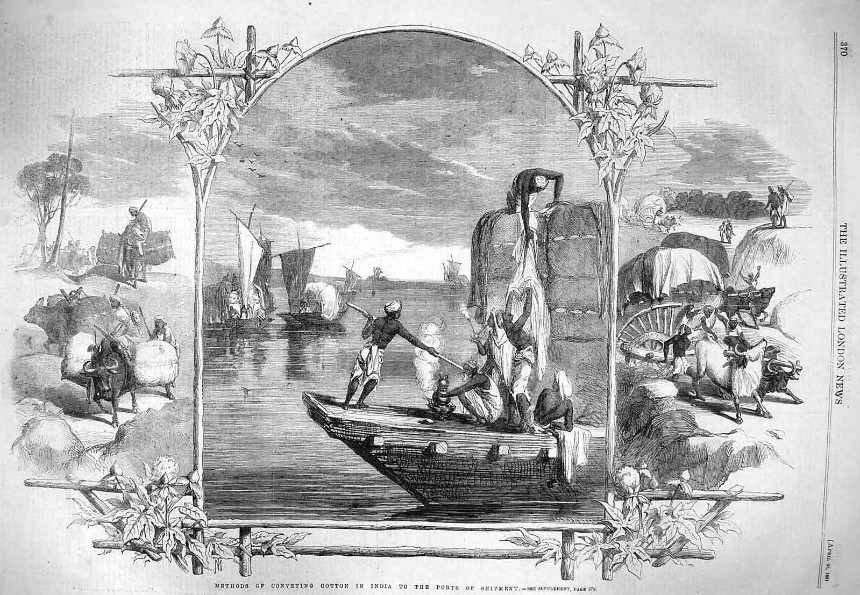
Methods of conveying cotton in India to the Ports of Shipment' Illustrated London News 1861
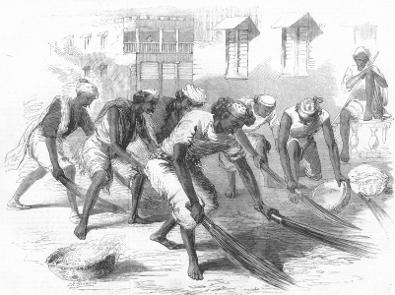
'Mehtahs, or Street-Sweepers in Calcutta' Illustrated London News 1860
'In Calcutta the road-sweepers belong to a Government department. Their operations are directed by a Sirdar, with something of military precision, and the cleansing effect is perfect. Thier peculiar switch-like brooms are used with a degree of expertness really astonishing, and with so much regularity that the roads, after being swept, present very much the appearance of the lines on an engine-turned watch-case. The Mehtah, although ignored by other castes as one in whose touch is contamination, has no mean opinion of himself, and his self-esteem is plainly observable in the care with which he arranges his dress, which, though scanty, is usually of the brightest colours; and his jet-black, curly hair, oiled and combed with such scrupulous pains, is usually crowned by a very small tinsel-bordered skull-cap of fine muslin, which he sticks on jauntily much on one side.'
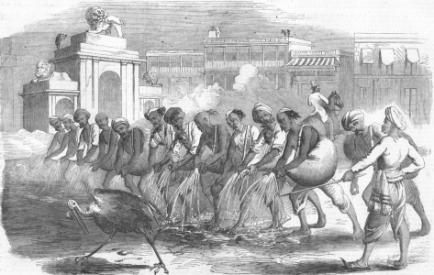
'Watering the streets of Calcutta' Illustrated London News 1858
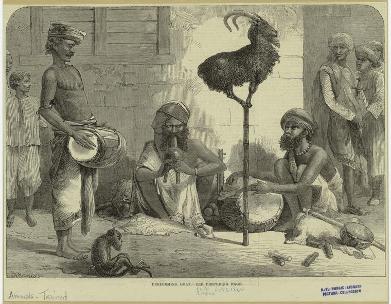
'Performing Goat' Illustrated London News 1864
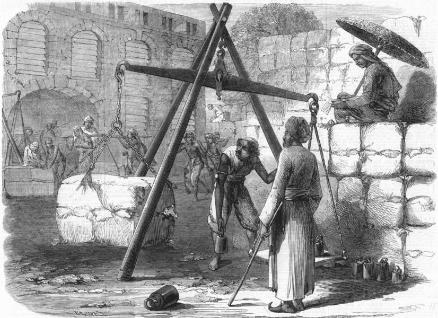
'Weighing cotton at Bombay for the English market' Illustrated London News 1862
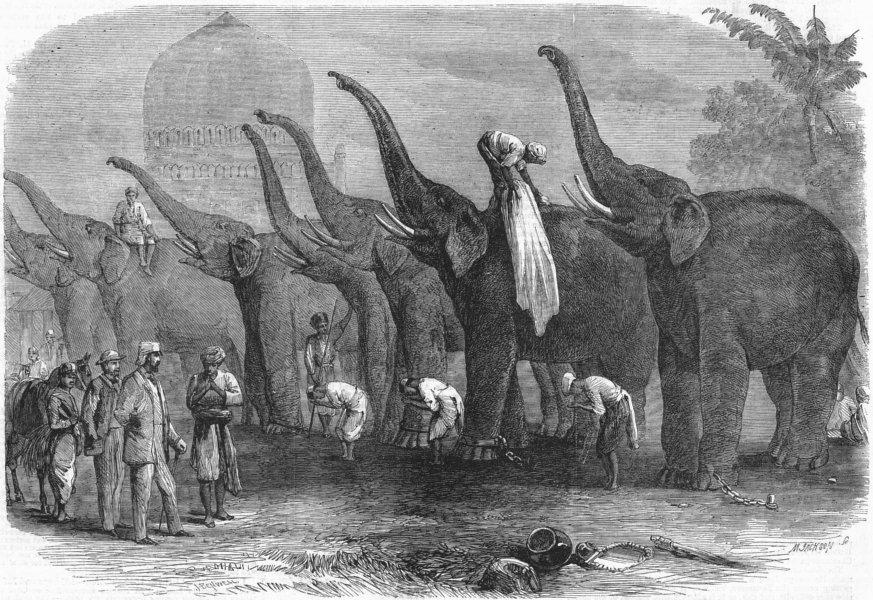
'A squad of elephants saluting the commandant at Dinapore, India' Illustrated London News 1864
''The scene was sketched by our Artist at Dinapore, where a considerable squad of elephants was temporarily picketed, affording him many opportunities of studying their habits. On this occasion the Commandant of the station was inspecting them, and as he passed down the line the word "Sulaam kurro" was loudly shouted by the mahouts, who themselves made a low salaam, as the elephants immediately poised their trunks perpendicularly in the air. Each elephant is tied by the foreleg to a picket driven into the ground, and is thereby kept in his place; the chain or rope used for this purpose seems inadequately slight and weak, and, indeed, it would require but a small effort on the part of the animal to free himself; but his sense of duty forbids this, and so accustomed are these docile creatures to second the will of their keepers that a very small cord would, in most cases, be sufficient to keep them in their places.'
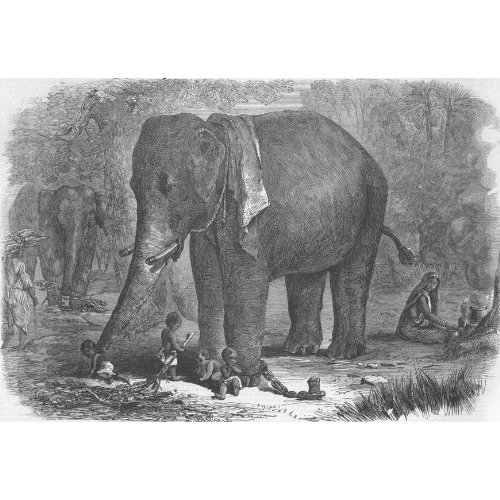
'An Elephant taking care of children' Illustrated London News 1863
'The sketch was taken at a halting-ground on the high road to Benares, where a party of mahouts, with their families, had encamped for the night. The wives, engaged in preparing the evening meal, had confided their offspring to the care of one of the huge quadrupeds of the party, and it was curious and interesting to observe the anxiety of the brute to perform the office intrusted to it conscientiously. Two of the babies, more nimble than the others, caused it great anxiety, for they were constantly trying to crawl beyond the limits of the chain tether, and more than once had nearly succeeded; but the watchfulness of the nurse was not to be eluded, and with the utmost gentleness it would lift its tender charges with its huge proboscis slowly within the limits assigned for them, generally between its forelegs. The mothers the while seemed perfectly confident as to the children's safety, seldom turning their eyes from the pot of rice bubbling in the chula.'
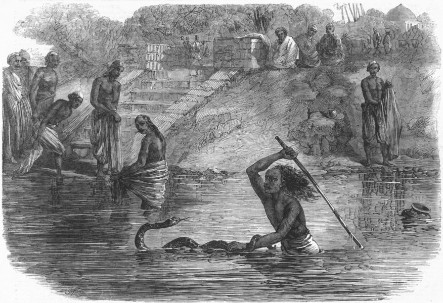
'Hindoo bathers in the river Jumna surprised by a snake' Illustrated London News 1864
'Large water-snakes abound in the canals and nullahs flowing into the Jumna about Delhi. The scene here represented is not uncommon in that part of India. A peculiar fearlessness or recklessness of danger is characteristic of the natives; it is the same quality which has often prompted them to attack a leopard or, in some rare instances, even a tiger, single-handed, and with only a latee or long stick for a weapon; or to mount a savage, bare-backed horse, the rider himself without any covering but the small dotie or waist-cloth. In the instance here depicted, the native will swim after the snake several hundred yards in midstream, with a strong current. ....
In the scene depicted by our Artist the man was wading in a shallow part of the river. The scene is very animating and exciting, for the snake, when hard pressed, will turn and show fight; but he is usually killed without inflicting more injury upon the man than temporary loss of breath and exhaustion. These snakes are often six ft. long, and their bite is very severe, though it is not venomous.'
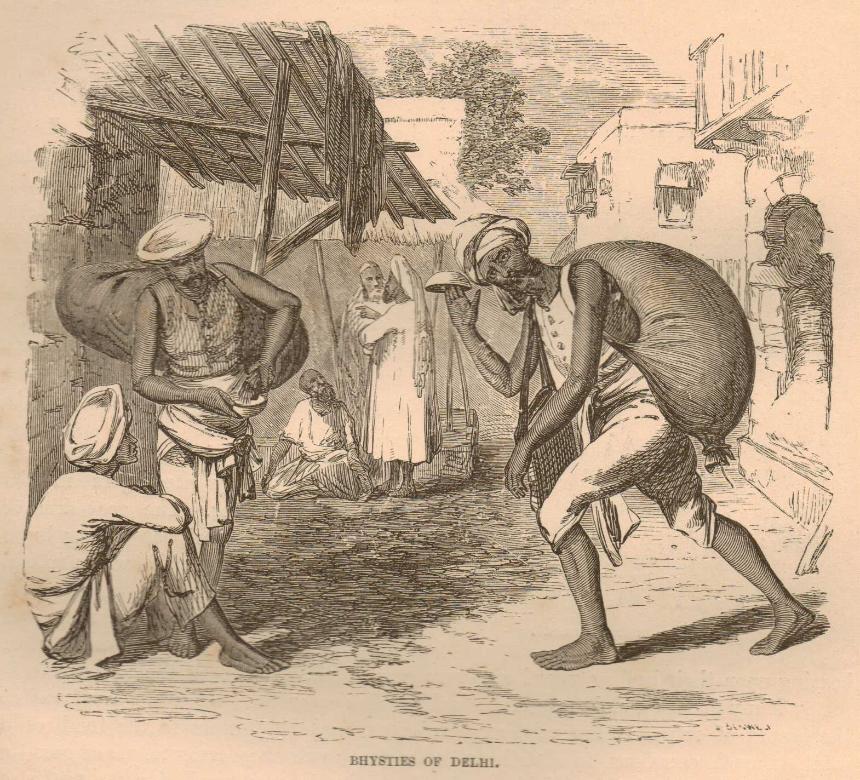
'Bhysties (water carriers) of Delhi' from ‘Rays from The East, or Illustrations of the Holy Scriptures, derived principally from the Manners, Customs, Rites, and Antiquities of Eastern Nations’ (1871)
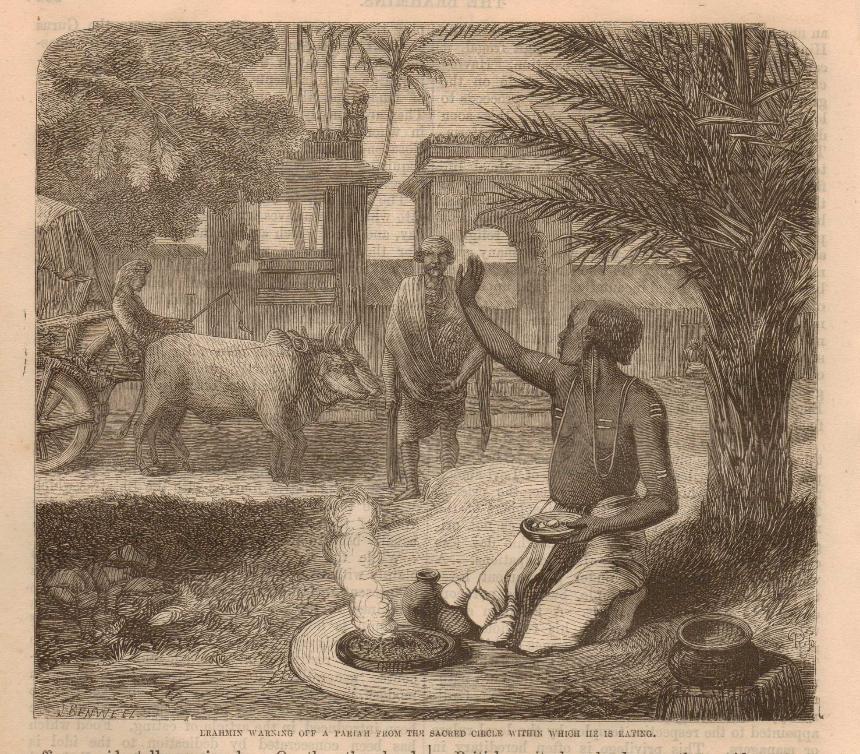
'Brahmin warning off a pariah from the sacred circle within which he is eating' from Sunday at Home, 1864
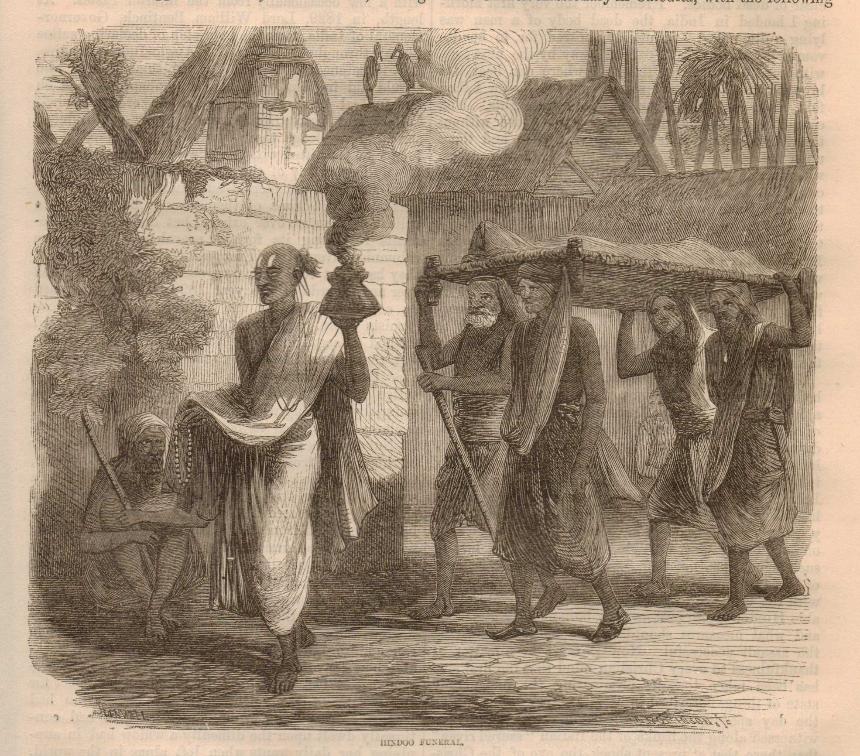
'Hindoo Funeral' from Sunday at Home, 1865
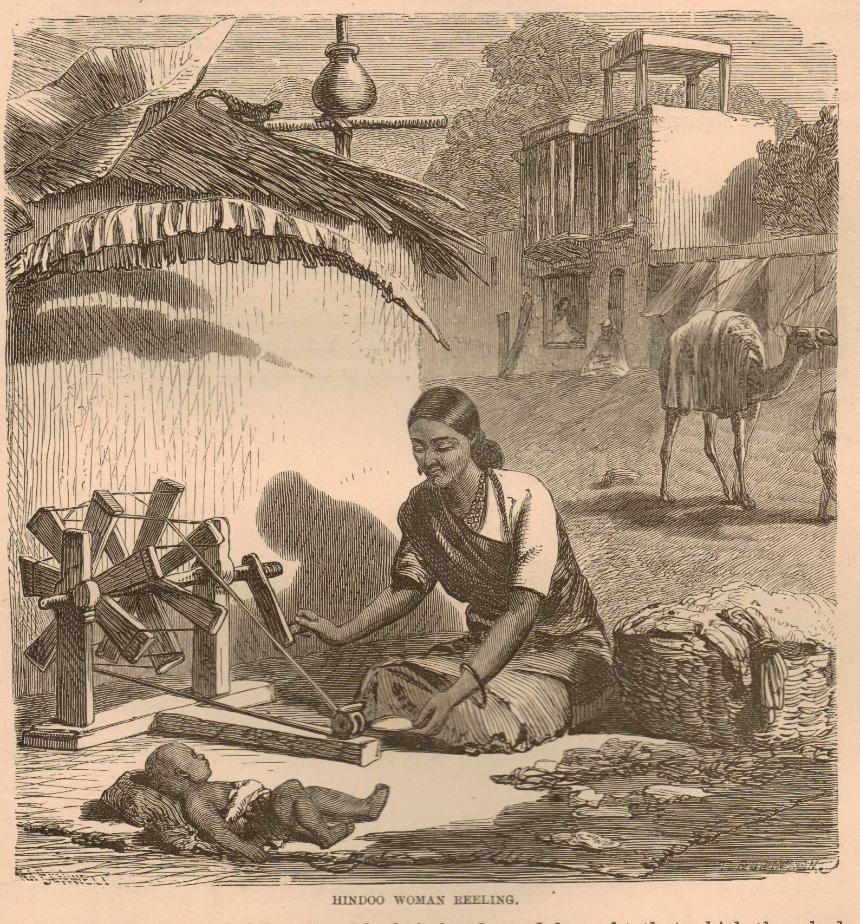
Hindoo Woman Reeling' from ‘Rays from The East, or Illustrations of the Holy Scriptures, derived principally from the Manners, Customs, Rites, and Antiquities of Eastern Nations’ (1871)
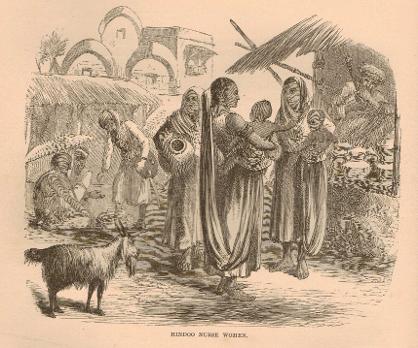
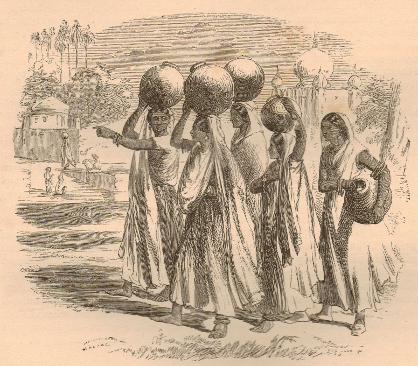
'Hindoo Nurse Women' and 'Hindoo Women going to the Well' from ‘Rays from The East, or Illustrations of the Holy Scriptures, derived principally from the Manners, Customs, Rites, and Antiquities of Eastern Nations’ (1871)

'Hindoos going to an Idol Temple' from ‘Rays from The East, or Illustrations of the Holy Scriptures, derived principally from the Manners, Customs, Rites, and Antiquities of Eastern Nations’ (1871) .
This illustration also appeared as ‘Hindoos on their way to the Swinging Festival’ in ‘The Sunday at Home, a Family Magazine for Sabbath Reading’ 1857 (Nurse Grand in India, Chapter 3), where it is signed J Benwell, lower right. I have found that when engravings are used again in later publications, the original signature of the artist or engraver is often obscured or omitted.
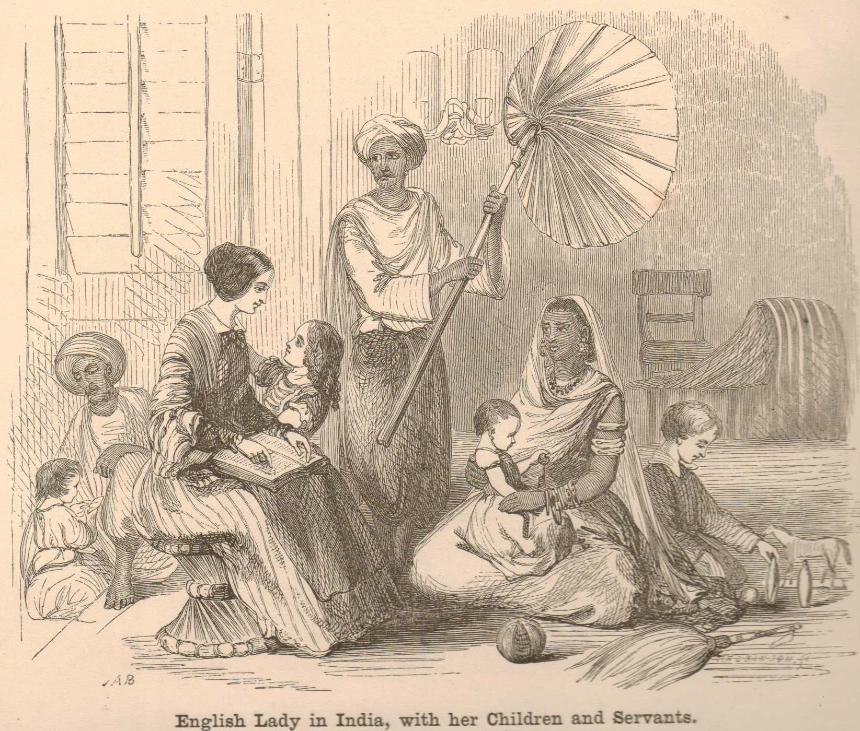
'English lady in India, with her children and servants' The Picture Scrap Book, or Happy Hours at Home, 1859
This illustration also appeared (right hand side of the image), as 'The Indian Nurse' in 'Grace Ogilvie; The Story of a Child's life in India during the Mutiny', published in 1872 by The Religious Tract Society. Please see below. The illustration was also used in The Sunday at Home 1857 (Nurse Grand in India) and later in 'Nurse Grand's Reminiscences at Home and Abroad' by Miss Brightwell, 1871 as 'The Ayah and her charge'.
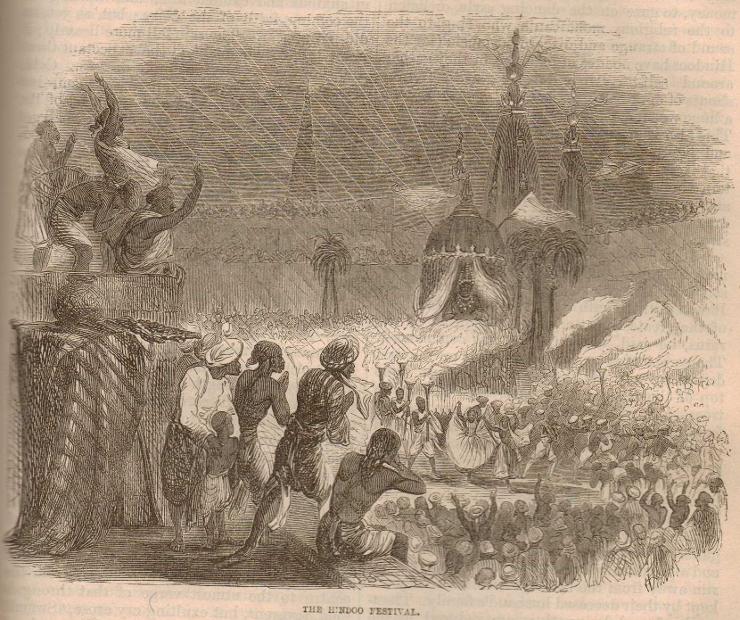
'The Hindoo Festival' from 'The Sunday at Home, a Family Magazine for Sabbath Reading’ 1857
This illustration also appeared in 'Grace Ogilvie; The Story of a Child's life in India during the Mutiny', published in 1872 by The Religious Tract Society.
My copy of this little book is inscribed in the front 'Ernest Salter Wills, Nov 1877, given by him to Violet E Wills.' Ernest Salter Wills was born in November 1869, and Violet was his sister. It seems likely that the book was given to him on the occasion of his 8th birthday. He was one of the Wills family of Bristol, tobacco importers and cigarette manufacturers, and later became Sir Ernest Salter Wills, Third Baronet of Hazelwood, and Lord Lieutenant of Wiltshire 1930-1942.
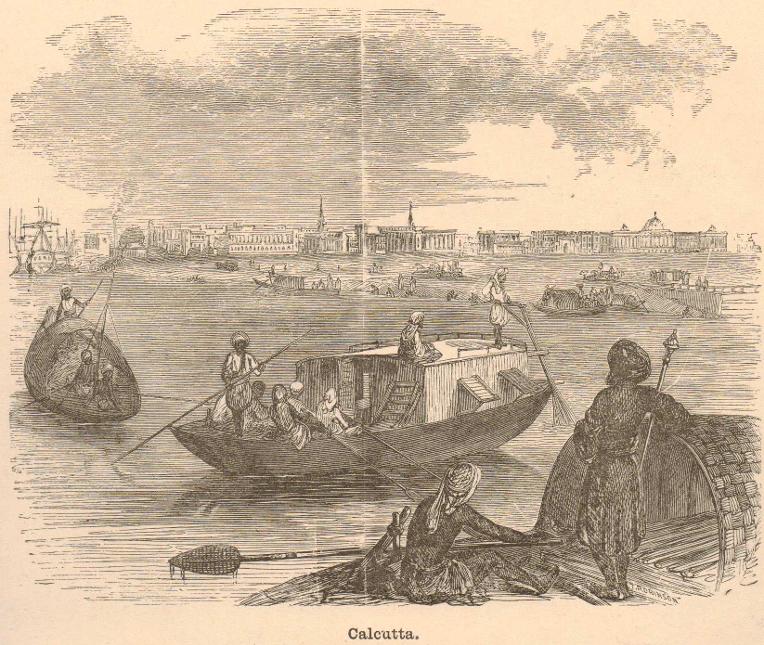
'Calcutta' The Picture Scrap Book, or Happy Hours at Home, 1855 (JB initials as artist left centre, T Robinson, engraver)
Also appears as 'View of Calcutta' in 'Nurse Grand's Reminiscences at Home and Abroad' by Miss Brightwell, 1871.
Benwell often worked with the engraver Thomas Robinson (1806-85), and both of their signatures or initials appear on many of Benwell's earlier illustrations. Thomas Robinson senior was a wood engraver who had worked for Thomas Bewick, who pioneered wood engraving technology at the end of the eighteenth century. One of Thomas Robinson's grandsons was William Heath Robinson (1872-1944), the acclaimed illustrator and cartoonist.
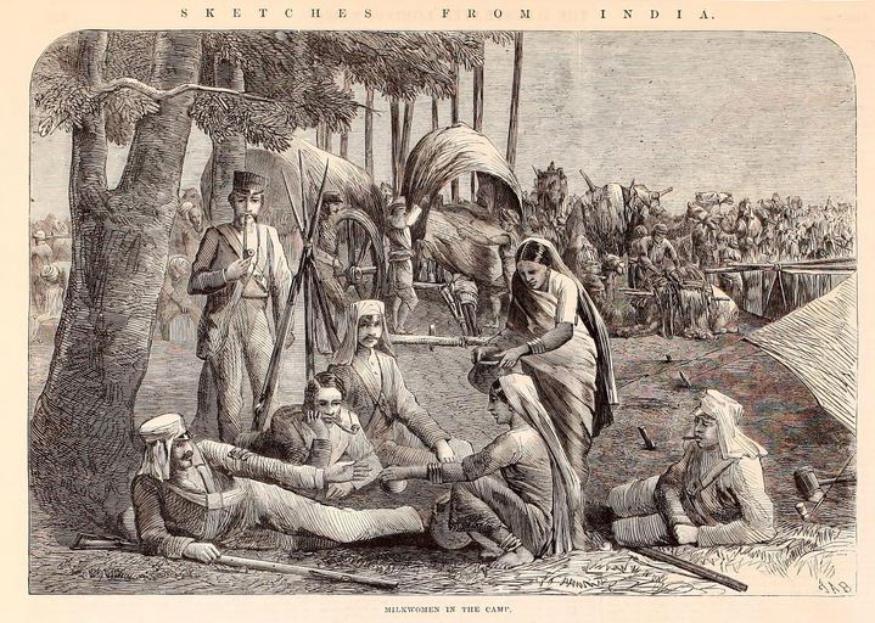
'Milkwomen in the Camp' Illustrated London News 1864
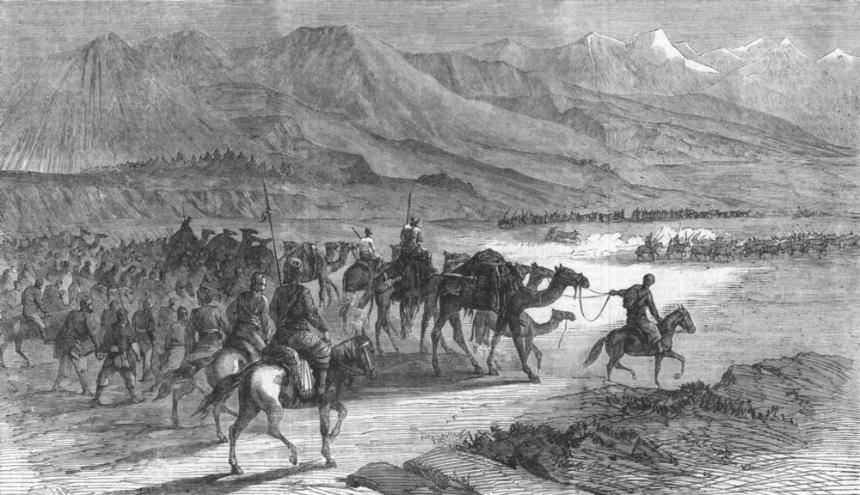
'Cattle-looting on the frontier of Scinde' Illustrated London News 1864
'Our Illustration shows a party of these predatory mountaineers, who have made a descent upon the villages in the plains belonging to another tribe, and are driving off all the cattle they can lay their hands upon, to the utter ruin, in most cases, of the poor owners thus violently despoiled. It is but a few weeks since the mountaineers of the Murree Hills, on the frontiers of Scinde and Beloochistan, near the Bolan Pass, made an extensive raid into Cutch and the district of Gundava, where they were very successful in their cattle-lifting operations, having carried off 500 head of cattle and 800 camels. This exploit seems to have emboldened them; for Major Green, the acting political superintendent on the frontier, reports, in a letter to the Commissioner of Scinde, that a strong body of the marauders, some mounted and some on foot, had since attacked the village of Poolagee, and were driving off all the cattle in the place; but some 300 men of the Munghals and Khyberees had been sent in pursuit, and would, it was hoped, recover a portion of what had been taken and give the cattle-stealers a wholesome lesson for the future.'
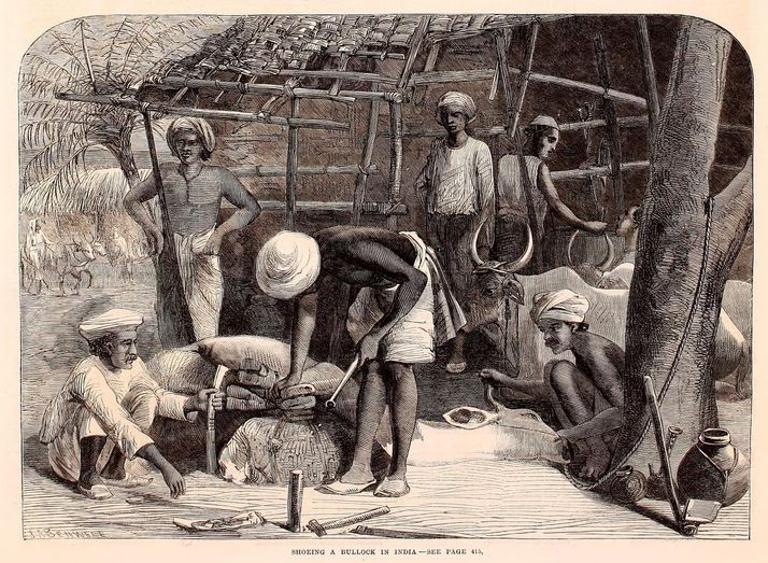
Shoeing a Bullock in India' Illustrated London News 1864
'An Indian Harlequin playing the Tiger' Illustrated London News 1864
'The Indian harlequin of bagh (tiger) plays an important in most public festivals in India. Like his brother buffoon in Europe, he jests and jokes, and these sallies never fail to excite the merriment of the vulgar..... Indeed, he seems sometimes to think that his assumed character of a wild beast invests him with a right to exercise the ferocious cruelty of the tiger; for, under the excitement of an Indian drug called "bang," he will fall upon a sheep or kid and kill t with his teeth. .... His body is painted so as to represent the stripes of a tiger, and he has coverings of the skin of that animal upon his hands, with sometimes claws attached to his finger-ends, which he uses whenever he finds an opportunity. A pair of tiger's ears and two hideous eye-pieces of green glass complete his grotesque disguise.'
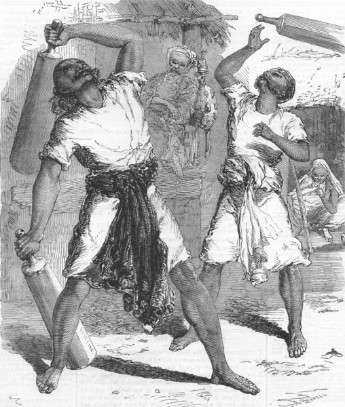
'Calisthenic exercises in India' Illustrated London News 1860
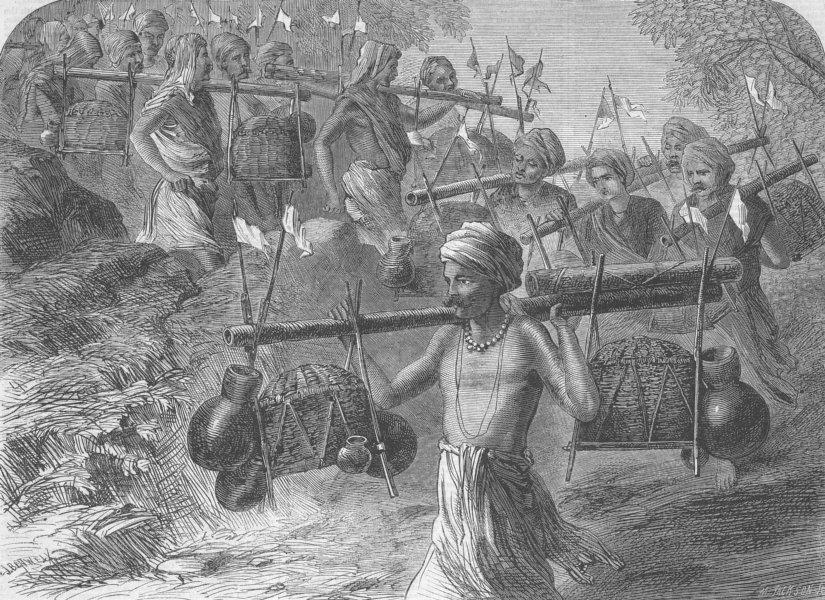
Ganges Pilgrims passing a Ghaut' Illustrated London News 30 January 1864 (also see below)
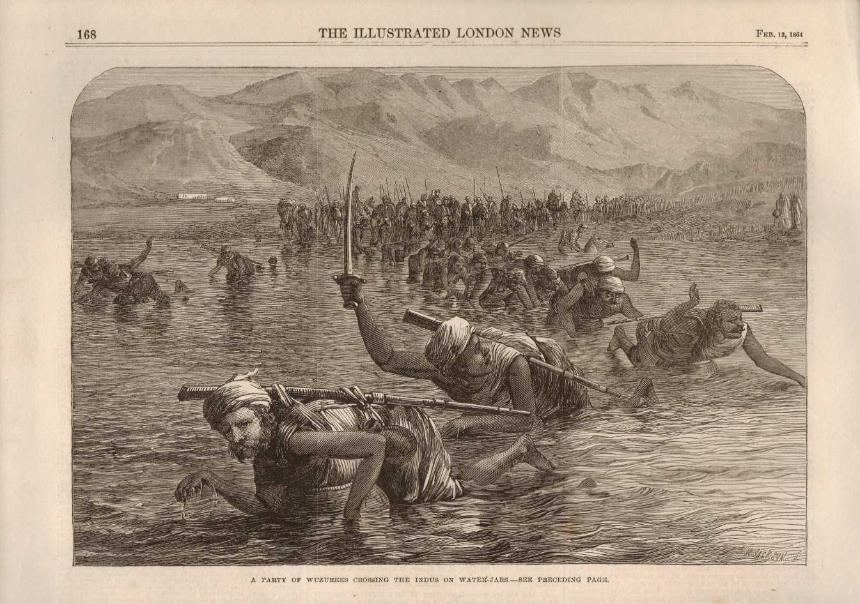
'A Party of Wuzurees crossing the Indus on water-jars' Illustrated London News 13 February 1864
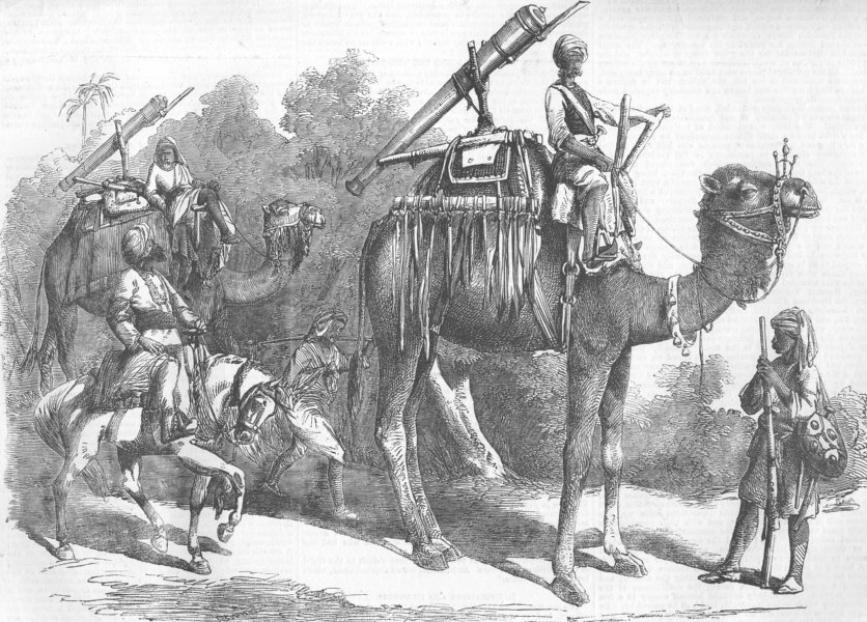
'Camel Jingalls' Illustrated London News 1858 (Indian Mutiny)
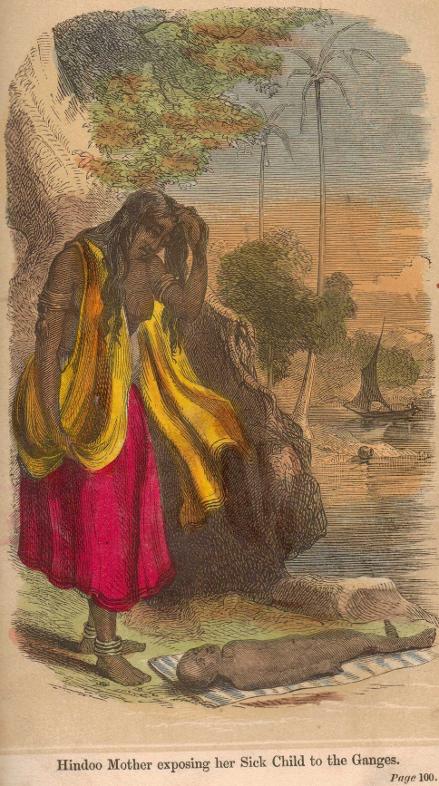
'Hindoo Mother exposing her sick child to the Ganges' from 'Our Oriental Kingdom' by Peter Parley (pseud. - William Martin), 1857 (believing that by such means the child's salvation is ensured)
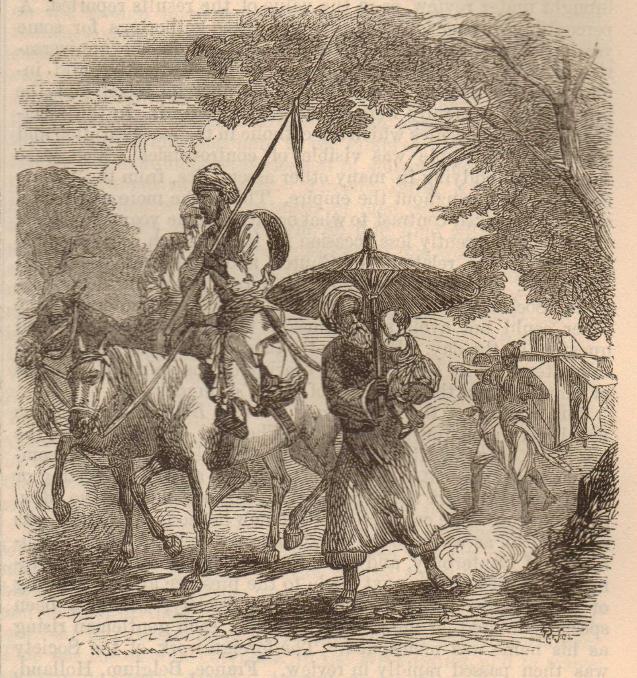
'Indian Bearer' from Page for the Young, European children in India (fleeing during the Indian Mutiny), The Sunday at Home, a Family Magazine for Sabbath Reading 1869
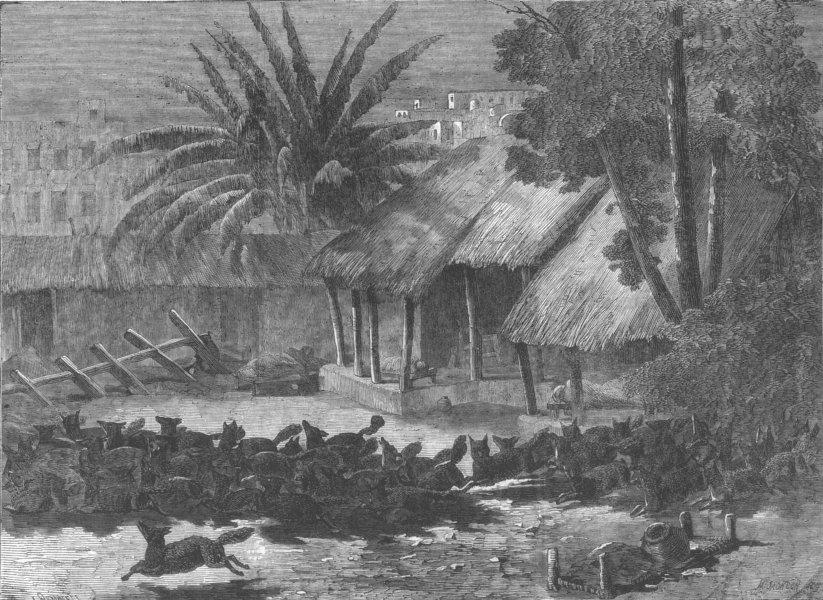
'A Stampede of jackals through the environs of Calcutta' Illustrated London News 1864
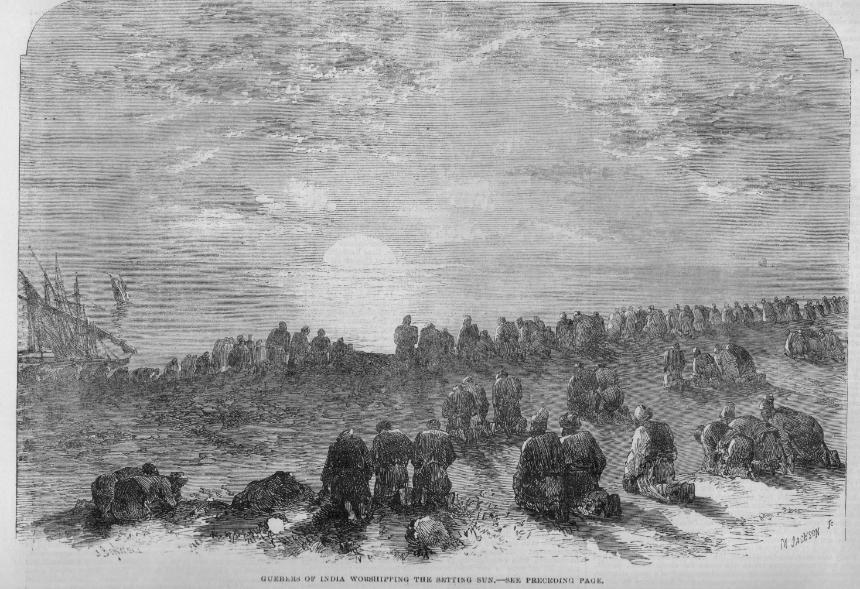
'Guebers of India worshipping the setting sun' Illustrated London News 1863
''These votaries of the sun, termed Guebers of Parsees, form a considerable portion of the population of India, especially on the western side, where they adhere strictly to to their religious forms and ceremonies. The effect of large crowds of Guebers standing on the sea-shore and praying aloud with arms uplifted is very striking. The murmur of their voices is powerful and constant, and has a singular effect when heard amid the dashing waves. During sunrise and sunset they line nearly the whole shore; and, from their dress, attitudes, and occupation, form an impressive spectacle. They stand with their faces directed towards the sun, and never for a moment turn from it till they have finished their religious duties, the performance of which usually occupies about a quarter of an hour. Their prayers are not repeated distinctly, but are muttered through the teeth, with a kind of inarticulate noise, without moving the lips.'
This illustration later appeared as 'Parsees worshipping the setting sun' from 'The S.P.G. Picture Book, showing origin, and scenes in the work of the Society for the Propagation of the Gospel in Foreign Parts' 1896.
Parsees and Guebers are descendants of ancient Persians who follow the Zoroastrian religion, many of whom fled to escape religious persecution.
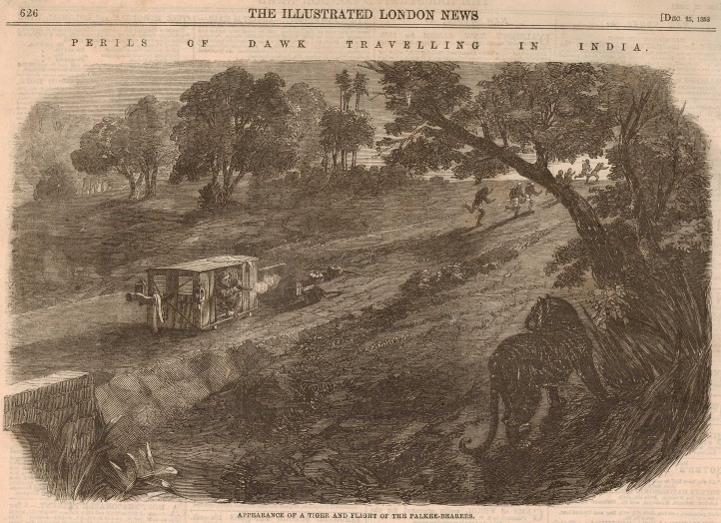
'Perils of Dawk travelling in India - Appearance of a tiger and flight of the Palkee-bearers' Illustrated London News, 25 December 1858
A thesis 'India in the Illustrated London News' 1857-1906, D Jessop, Australian National University, 1986, refers to the Illustrated London News printing narratives by the artist J A Benwell, to accompany his sketches (above and below).

'Perils of Dawk travelling in India - The traveller in his Palanquin beset by wolves, hyenas and jackals' Illustrated London News, 25 December 1858
“Mr Benwell, the artist to whom we are indebted for the two accompanying sketches, illustrative of the perils which beset travellers in India, supplies the following particulars concerning dawk travelling in that country… The remainder of the narrative is, however, best told in Mr Benwell’s own words: “In a state of perfect helplessness from the debilitating effect of the fever, I arrived at the Dawk bungalow.....”
"I composed myself for a short sleep, the stillness of the night and the cessation of motion being favourable to repose. I soon fell into an uneasy nap, from which I was disturbed by the sounds of sniffing close to my ears. Through the cane bottom of the palanquin came a strong menagerie-like odour, and the sniffing noises increased until I seemed completely surrounded by them.
I now began to realise my position. Fastening the sliding doors on each side, I peered through the small windows in front, and discovered, to my great consternation, that I, in my frail vehicle, and still more frail state of health, was beset by a pack of hyenas, wolves and jackals. Now, had I been able to stand, with a good stick in my hand, I might have sent the whole pack scouring off into the jungle; but to raise myself into a sitting posture required my utmost efforts, and to stand without assistance was quite impossible; this my fierce visitors seemed to be aware of, for their familiarities became truly alarming. The sniffings increased in vigour, and now and then a concussion against the panels from the violent contact of the snouts of some more eager than the rest showed that they were really in earnest. The short cachinnatory bark of the hyena was clearly distinguishable amid the howling of the jackals disappointed of their prey. An occasional knock with my fists against the door inside seemed only to stimulate the pack to renewed attempts to get at me, and I was beginning to give all up in despair when, to my unutterable relief, a faint glimmer in the distance told me that succour was at hand. The light was from the torches of the mussalchies, who, with the whole party of bearers, presuming on my helpless condition, had, disregarding my orders, been to enjoy a smoke in the village. As the lights approached, my assailants rushed pell-mell into the jungle. A howl, loud and of long continuance, dying away in the distant woods, indicated the direction the pack had taken; and, though dismal enough, appealed to my sense of gratitude for deliverance from the throats which gave utterance to it. The next morning I reached a civil station, where I obtained medical assistance and rest, which I badly needed, and in due course came on to Benares." (narrative by Benwell)
'Baking of the Indian Chapatis' The Leisure Hour: a Family Journal of Instruction and Recreation 1858
'Circulation of the Chapatis' The Leisure Hour: a Family Journal of Instruction and Recreation 1858
‘Glimpses of Delhi and its Interiors', including '‘Nadir Shah witnessing the massacre of the inhabitants of Delhi’. The Leisure Hour, A Family Journal of Instruction and Recreation 1858
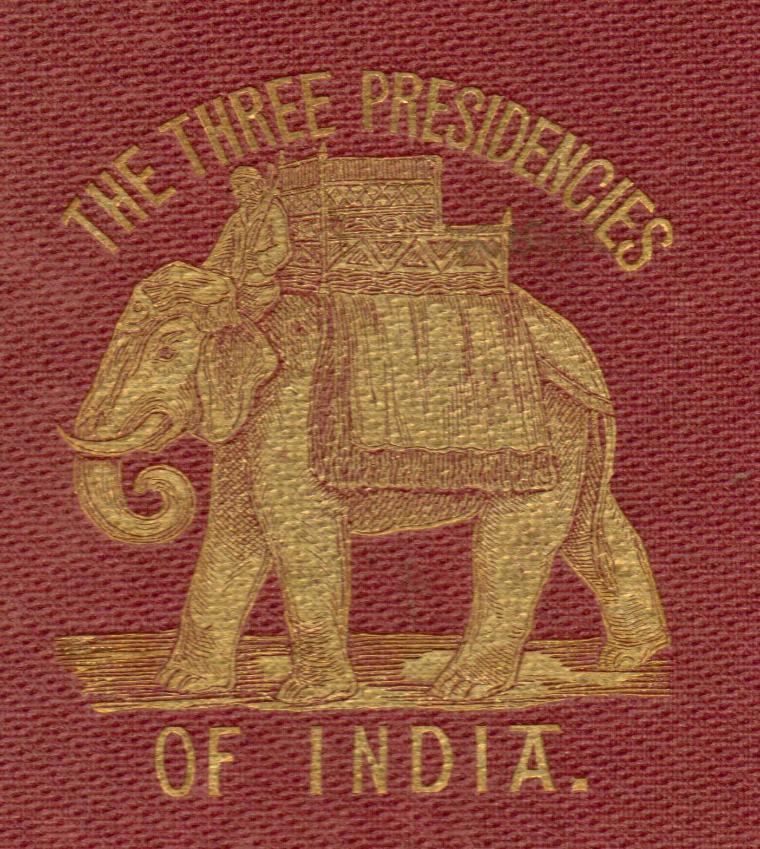
Detail from cover of 'The Three Presidencies of India' 1853, by John Capper, with engraving by Joseph Austin Benwell.
(See title page engraving below). First edition, gilt on decorative red cloth board.
Title page of 'The Three Presidencies of India' 1853, by John Capper, with engraving by Joseph Austin Benwell, initialled JB lower left.
A number of the engravings in 'The Three Presidencies of India' are also included in the 1857 book ‘Our Oriental Kingdom; or, Tales about India’ by Peter Parley (pseud.), or William Martin, published by Darton and Co, Holborn Hill, London.
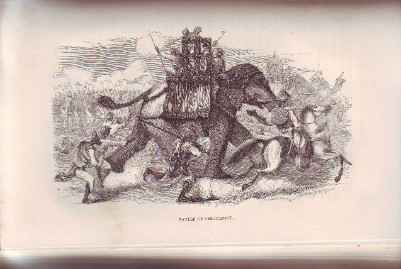
'Battle of Ferozepore' from 'The Three Presidencies of India' 1853
'A Nautch or Native Entertainment' from 'The Three Presidencies of India' 1853
'Storming of Ghuznee' from 'The Three Presidencies of India' 1853
'Indian Caravanserai and Travellers' from 'The Three Presidencies of India' 1853
'Procession at a Hindoo Festival' The Leisure Hour: a Family Journal of Instruction and Recreation 1858
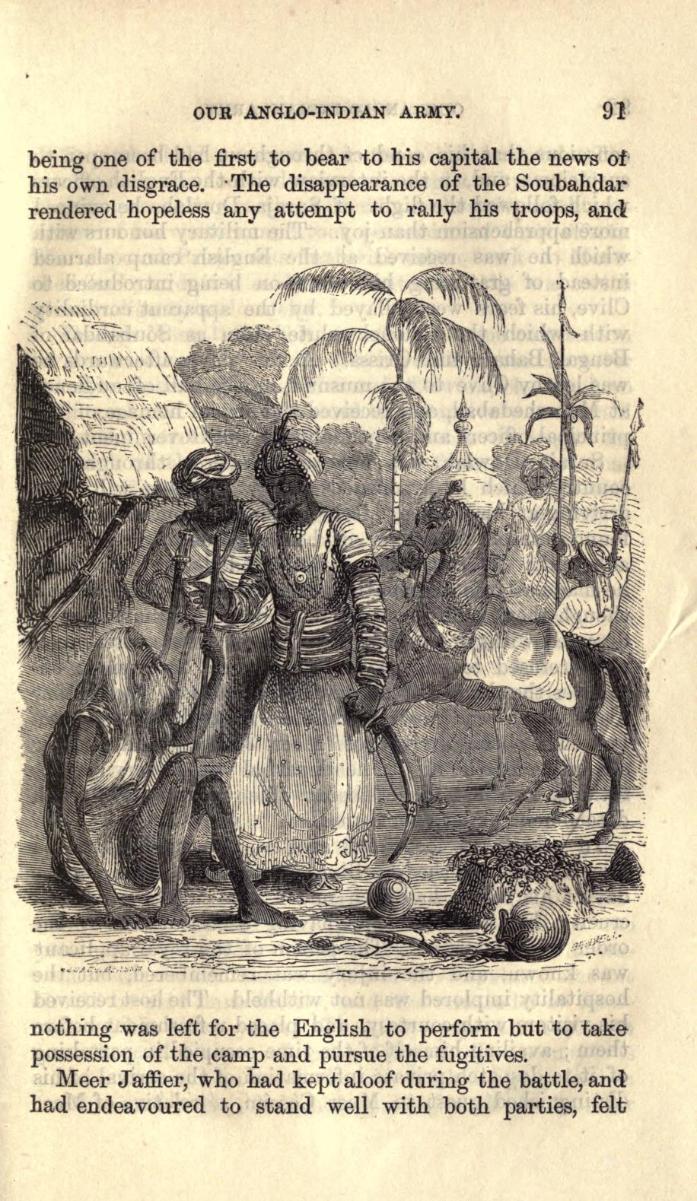
Example of Illustration by Joseph Austin Benwell on p91 of 'Our Indian Army' 1855, by Captain Rafter

Another example of Illustration by Joseph Austin Benwell on p142 of 'Our Indian Army' 1855, by Captain Rafter (one of many)
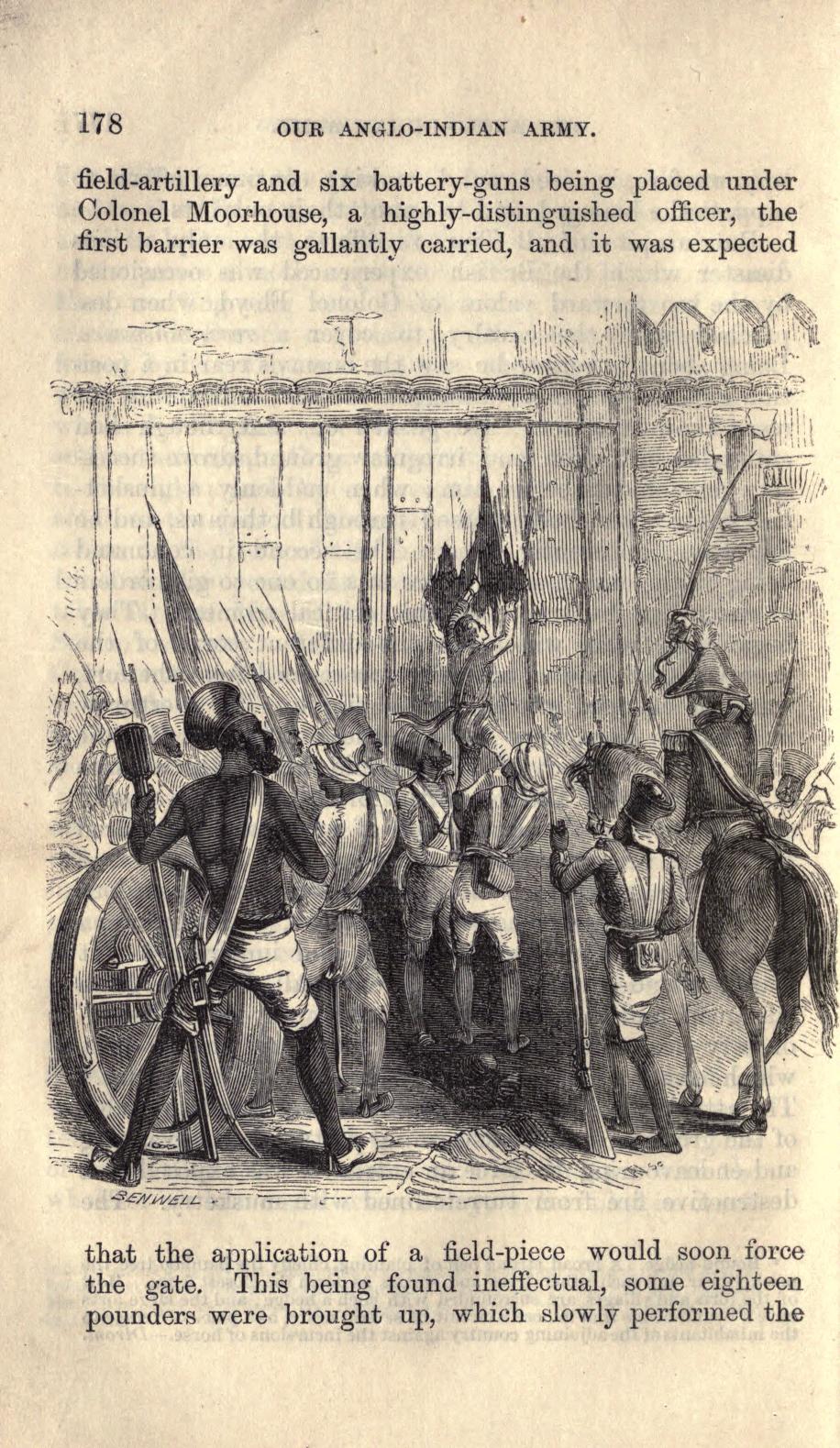
Another example of Illustration by Joseph Austin Benwell on p178 of 'Our Indian Army' 1855, by Captain Rafter.
Illustration by Benwell (signed lower left) on page 155 of 'Our Indian Army' 1855 by Captain Rafter. It depicts Colonel Baillie waving a flag of truce at the Battle of Pollilur in 1780 after defeat by Hyder Ali.
Page 262 'Our Indian Army' 1855, by Captain Rafter
Page 313 'Our Indian Army' 1855, by Captain Rafter
Page 420 'Our Indian Army' 1855, by Captain Rafter
Page 433 'Our Indian Army' 1855, by Captain Rafter
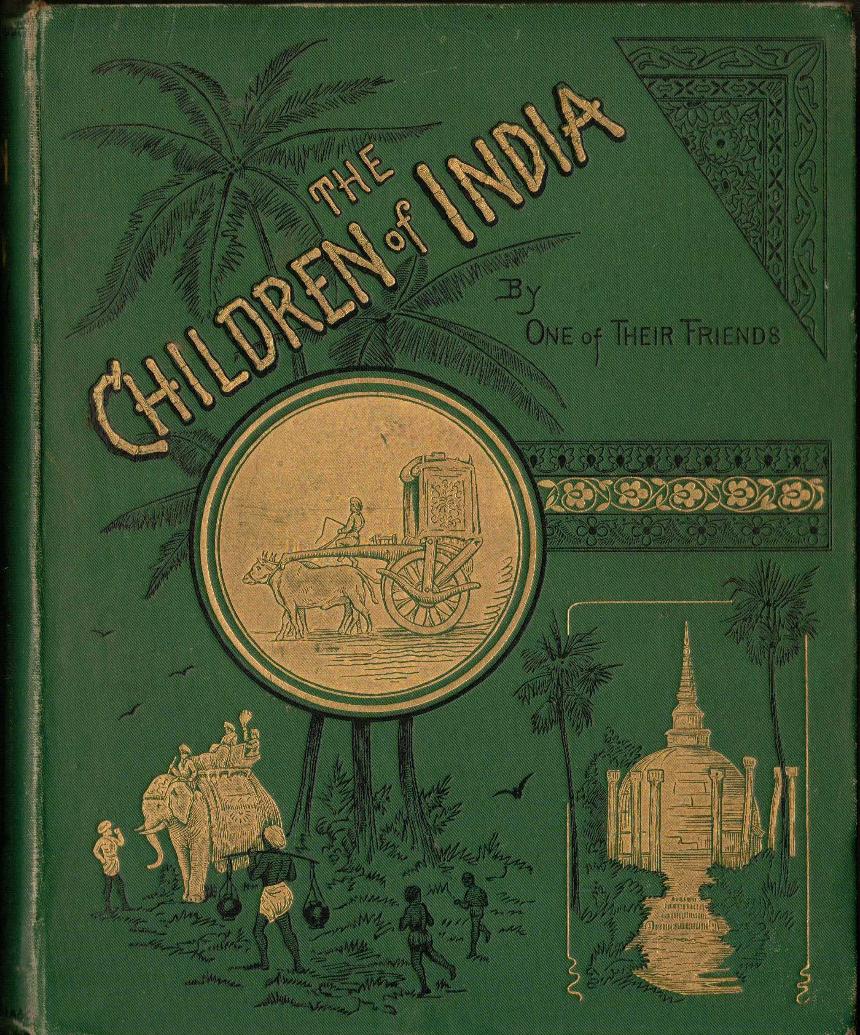
Cover of 'The Children of India, written for the Children of England by one of their Friends' by Annie Westland Marston 1883, published by the Religious Tract Society (various illustrations by J A Benwell)
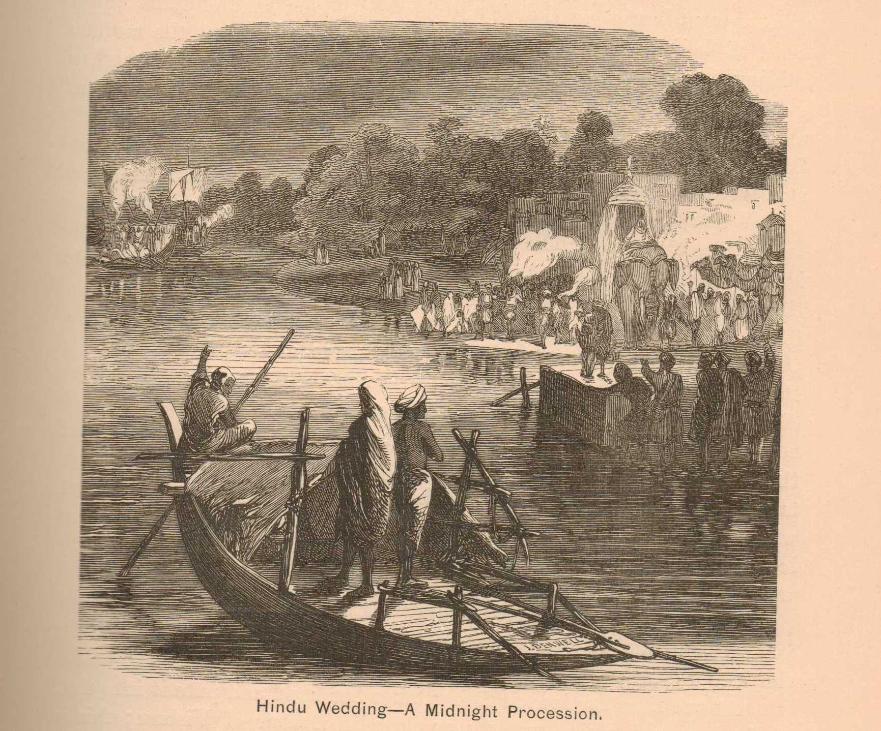
'Hindu Wedding - A Midnight Procession' an illustration on page 67 by J A Benwell from the above book 'The Children of India' 1883
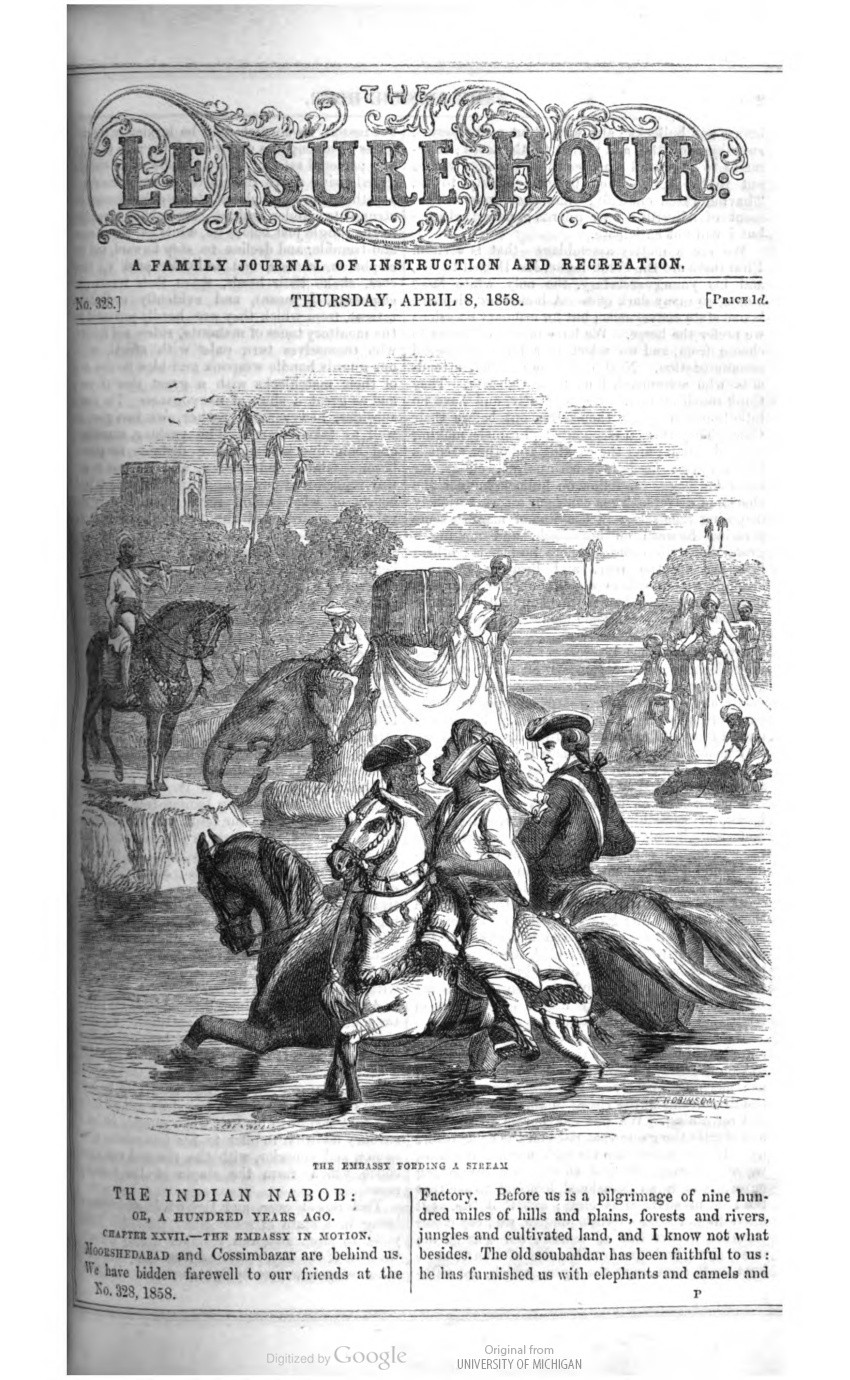
Example of Illustration by Joseph Austin Benwell on p209 of 'The Leisure Hour', 1858, from the series 'The Indian Nabob, or A Hundred Years Ago'
'The Embassy fording a Stream'
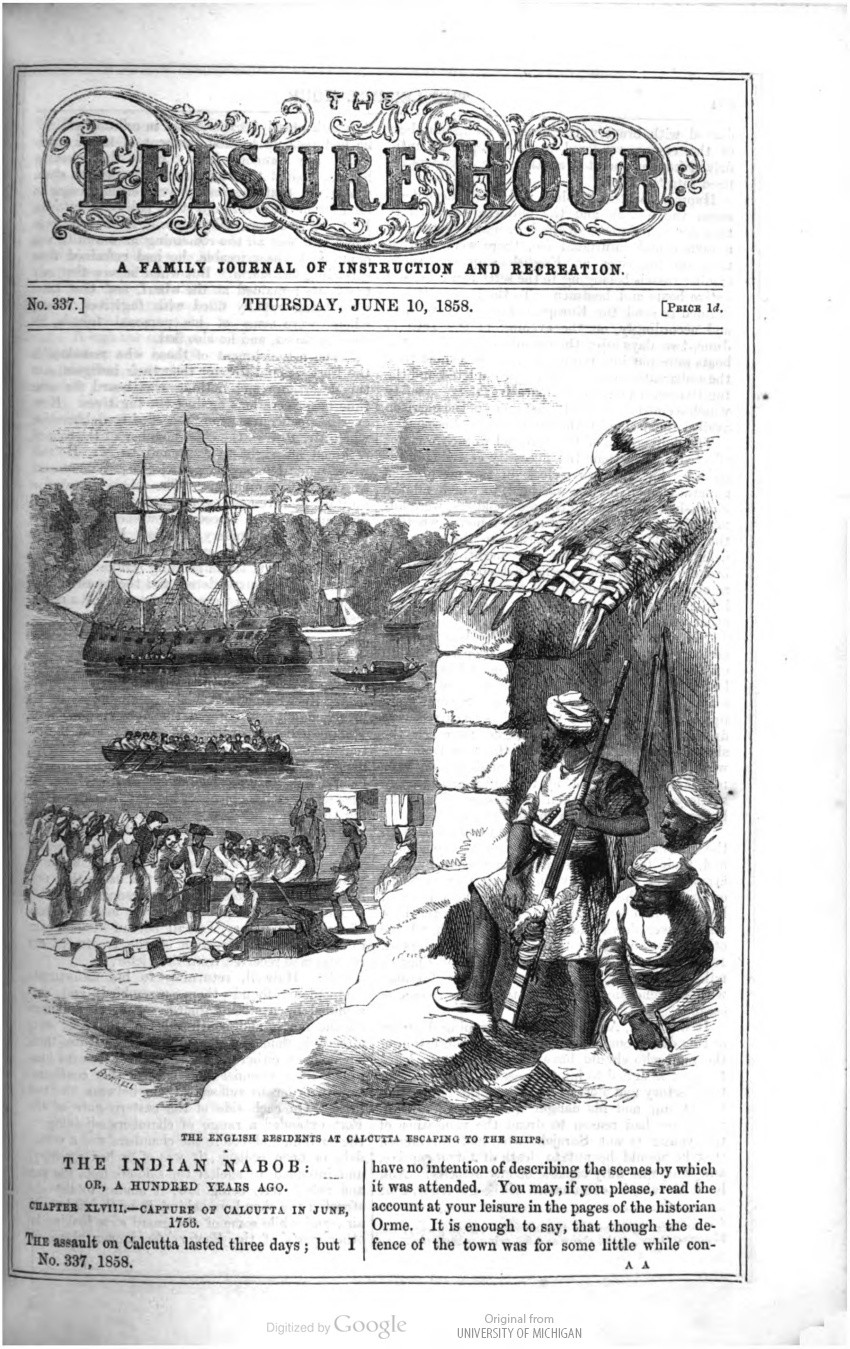
Example of Illustration by Joseph Austin Benwell on p353 of 'The Leisure Hour', 1858, from the series 'The Indian Nabob, or A Hundred Years Ago'
'The English Residents at Calcutta Escaping to the Ships'
'The British reinforcements welcomed by the fugitives at Fulta' 'The Leisure Hour, 1858, from the series 'The Indian Nabob, or A Hundred Years Ago'
'Hindoo Serpent-Charmers' 'The Leisure Hour, 1858, from the series 'The Indian Nabob, or A Hundred Years Ago'
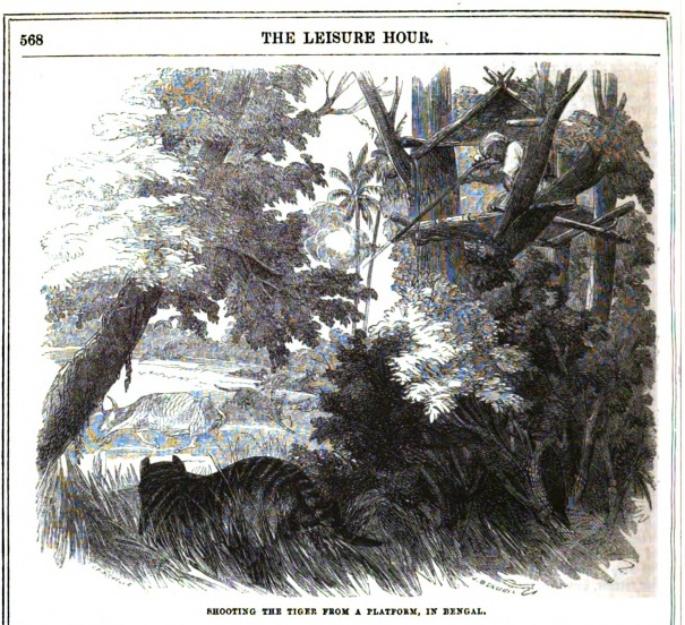
'Shooting the tiger from a platform in Bengal' from 'Tigers in India', The Leisure Hour 1857
Material researched and written by Dee Murray. Website compiled by Dee Murray.
All images on this website are either scanned or photographed from the author’s own resources, or are in the public domain in digital format via websites such as HathiTrust, Openlibrary.org, the Internet Archive (archive.org) or Google Books.